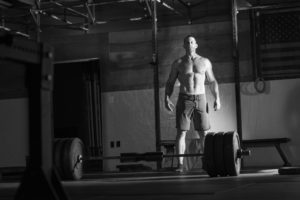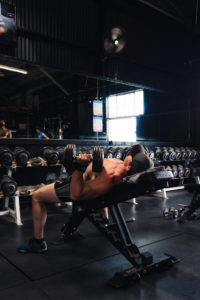Alright, the science continues to pile on with support for training exercises at “long muscle lengths.”
There are now 7+ studies in the last few years that all have demonstrated an advantage to training in this manner.
At Evolved, we were on top of this a year ago, with the “Progressing the Stimulus” cycle. Personally, I’ve been experimenting with techniques to further bias the “lengthened” position of movements for two years. I am fully a believer in it.
So wait, what exactly are “long muscle lengths” and “the lengthened position of movements”???
We can think of muscles as having a short position and a lengthened position. In a bicep curl, the arm bends and contracts, which shortens the muscle. When we lower the weight down, the arm is lengthened, and the muscle is stretched.
In a very binary way, we can think of exercises as being one of two types:
1. Lengthened Overload Movements
2. Short Overload Movements
There are also mid-range overload movements (and many movements are actually mid-range, but we will call them either short or lengthened based on the bias of each movement).
While not always the case, it is common that the “compound” movements are lengthened overload, where isolation movements are short overload.
However, the true determination, is where the movement is hardest. Where would you fail if you were to fail?
Squat variations, RDL/Deadlifts, and Bench press variations are all hardest at the bottom and have literally no resistance on the target musculature at the top. The weight is essentially supported through joint stacking at the top of the rep.
Leg Extensions, Leg Curls, DB Lateral Raises, and almost all Row or Pulldown variations are examples of short overload movements (where the exercise is most challenging at the contracted position).
The pulldown or row is also an example of a compound movement that is NOT lengthened overloaded.
A free weight Tricep Extension (“skull crusher”) is an example of an isolation movement that is lengthened overloaded (hardest at the stretched position for the tricep).
When you look at a DB fly versus a Cable/banded crossover, you’ll see two movements that have an identical arm path, but one is hardest in the lengthened/stretched position, and the other is hardest in the short/contracted position.
So why does this matter?
The application of training has been widely misapplied by the masses.
This is not the fault of the consumer, because prioritizing the lengthened position of movements is actually counterintuitive. It’s at the short position, the top of the bicep curl or leg extension, where you can really “feel” the muscle working. It’s easy to associate this “squeezing” sensation as something good; when in reality it’s the stretching of the muscle under load that produces most of the muscle growth we covet.
Short overload movements are just not all that stimulative. There seems to be only a small portion of the range of motion that has any significant tension (muscle-building effect); and that is the lengthened portion of the exercise.
This section will uncover some ways in which we can get more out of these types of exercises.
The other factor is that we need to control the fatigue accumulation of the compound movements.
We will almost never go to COMPLETE FAILURE for one of these lengthened compound movements. The injury risk and fatigue cost are just too high for the stimulus that you get.
Many studies now have shown that 1-3 reps from failure produces equivalent hypertrophy as going to failure. The caveat here, is that the majority of these studies have been conducted on these demanding lengthened compound movements.
Studies have also shown that we may need to train closer to failure on the isolation movements to illicit similar gains.
Over the last 3 years or so, studies have very convincingly shown that there are significantly more gains to be had by accentuating the LENGTHENED position of reps.
Leg Extensions – Pedrosa and colleagues; https://pubmed.ncbi.nlm.nih.gov/33977835
Leg Curls – Maeo and colleagues; https://pubmed.ncbi.nlm.nih.gov/33009197
Tricep Extensions – Maeo and colleagues; https://pubmed.ncbi.nlm.nih.gov/35819335
Preacher Curls – Nunez and colleagues; https://pubmed.ncbi.nlm.nih.gov/32823490
Without thoroughly reading the studies above, just take a quick look at the movements that are studied. All of them are isolation “single joint” exercises.
All of these studies were conducted to delve into the idea of “biasing” the lengthened portion of movements that are inherently “short overloaded.”
Just to BRIEFLY discuss the most prominent finding, this is what happened in the Leg Extension study.
This was a within-subject design, in which one leg performed a certain range of motion, while the other leg completed a different range of motion.
There were 5 ranges of motion assessed, but for what we care about, we can focus on three of them:
1. Full Range of motion
2. Just the BOTTOM of the rep (stopping about halfway up)
3. Just the TOP of the rep (avoid lowering all the way down)
The findings were that the BOTTOM ONLY range of motion (essentially the “lengthened” portion of the rep) produced MORE muscle gain than both other groups.
The Full ROM group was close to the BOTTOM ONLY group, but the group that trained “only the top of the rep” was way behind.
These studies have illustrated that it is in fact the deeper stretch position in which the muscle opens up and allows all these “hypertrophy molecules” to flood the cell and enhance the muscle building process.
—————
So how can we bias the lengthened position of short overload movements?
Let’s take a Row movement as an example. A simple DB Row. Because it is short overloaded, you will fail in the ability to complete a FULL REP, but you will still be able to manage 90% of the range of motion. In effect, this is exhausting the short position (the contraction), but it isn’t fully training the lower portions of the range of motion (which are potentially MORE beneficial ranges for hypertrophy).
This is precisely why I’ve began using two new tools in my programming of short overload movements:
1. Partial reps after failure
This means that you successfully reach “failure” of full range of motion reps. Then, despite your maximum effort to achieve a full rep, you only can achieve 80-90% of the rep. I will usually program these in sets of 3-6 partials, where you may see the range of motion finish at 25-40% of the full range of motion (as you would expect ROM to decline with each partial rep, due to accumulation of fatigue)
2. Reverse Dropset
More rarely will I use the Reverse Dropset. It is more of a sledgehammer approach, where the partials may be considered a bit less demanding. In a reverse dropset:
A. Complete FULL REPS to 1-2 Reps from failure
B. QUICKLY add 20-25% weight
C. Accumulate partial reps to equal the “full reps” achieved
Example:
DB Row 60# x 9 Reps (1-2 reps from fail)
Quickly switch out to the 80# DB
Accumulate approx 9 partial reps with 80#
—
The Progression of Proximity to Failure
Across the various movements programmed, we will see two different progression models.
For the lengthened overload movements, we discussed above:
Week 1: 3-4 reps from failure
Week 2: 2-3 reps from failure
Week 3: 1-2 reps from failure
Week 4: ~1 rep from failure
For the short overload movements, it may look like this:
Week 1: 1-2 reps from failure
Week 2: 0-1 reps from failure
Week 3: Add partial reps
Week 4: Reverse Dropset (or more partial reps)
We have the confounding variable of handling lengthened overload isolation movements. We can’t do “partials” in something that fails at the bottom.
Imagine doing a DB Fly after failure. You’d just get stuck at the bottom, so it is not conducive to the use of partials.
The “rest/pause” set is a great way to add intensity to isolation movements without incurring a ton of fatigue (as would be the case if you tried to do rest/pause sets on a squat or RDL).
In a rest/pause set, you complete a set close to failure. Then rest an INCOMPLETE amount of time. Usually this is somewhere between 10-30 seconds. You will then continue to accrue reps on the same exercise. In application, it may look like:
DB Fly x 10-12 Reps
Rest 15-20 seconds
DB Fly x 4-6 Reps
Rest 15-20 seconds
DB Fly x 3-5 Reps
In effect, we’ve accumulated a ton of super hard reps close to failure, but did this in a time-effective manner. Instead of using normal “full rest” and having to do these initial “easy” reps, just to get to the hard stuff, we essentially get right to the good stuff.




